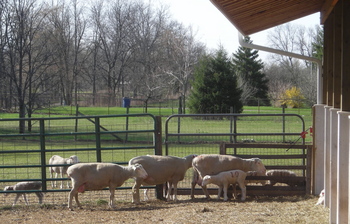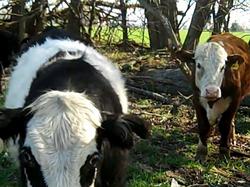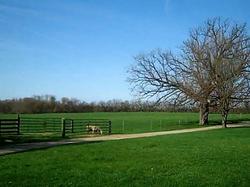Lamb Farm gambols in the sun
This is the first part in a discussion of Lamb Farm and their retail partner Arbor Farms - focusing on Lamb Farm’s side of the handshake, look for Arbor Farms’ side tomorrow!

New lambs with their ewes.
Corinna Borden | Contributor
John Smucker gazes over the verdant pastures and smiles, his eyes crinkling, “The key to this whole thing is the soil. Because whatever the soil is, is going to wind up in the plant, is going to wind up in the animal, is going to wind up in you!”
The neatly kept buildings, glowing green fields and the 1910 extant barn on John and Suzanne Smucker’s Lamb Farm are mute testimony to such careful detail awareness in all aspects of the carefully maintained landscape.
John Smucker explains that he and his wife were, “always orientated to organic food, so we thought that would make sense.” Lamb Farm began in 2001 growing organic soybeans and rye, but soon the Smuckers realized the benefits of using their land as pasture. Today their 180 acres of carefully cultivated fields provide food for around 40 cattle, 60-plus ewes and more than 100 lambs.

Corinna Borden | Contributor
Smucker continues, “we are certified organic and are a pasture-based system - the only exemption to that are the lactating ewes - we give them minimal amounts of grain to support their lactation. We go through the organic certification process because we want people to know that we adhere to the rules, this way we try to maintain an ethic to what we are up to.”
Based on Joel Salatin’s Polyface Farm rotational grazing model expounded upon in Michael Pollan’s The Omnivore’s Dilemna, Smucker cordons off his pastures into 5-acre plots and rotates the cows and the sheep every four to five days. “Our model is basically his model, we do interspecies grazing on a smaller scale.” Interspecies rotational grazing encourages a wide variety of different plants, plant diversity increases in pastures that have been allowed to rest between grazings, and often weeds like dandelions and quackgrass are removed by the ruminating masses - to their dietary benefit.

Corinna Borden | Contributor
The rolling hills may look effortless and idyllic but a lot of hard work goes into maintaining fields for the herds of predominately Cordale Sheep and Hereford Cattle. Every two years a complete soil sample is taken of the fields and an individual plan is designed for each field depending on needs of the farm and the microclimate. Lamb Farm makes their own compost to spread back over the fields and they “mow back in a lot of the organic matter. The more you mow it the richer it becomes.”
I was lucky enough to visit during lambing season. The process begins when the rams are introduced to the ewes (starting about a year and a half old) for a month, the gestation cycle is five months, and “in the first two weeks of birthing this year we birthed 110 lambs out of the 60-plus ewes.” Remembering James Herriot freezing on stone floors in Yorkshire helping to pull out lambs, I asked how much of that happens at Lamb Farm. “We have to help pull maybe three or four - for the most part these girls can birth on their own. Cordale tend to be very hardy pasture animals.”
The lambs are kept with their mothers in the lambing pens for two weeks until they are moved outside to the fields. A lamb only qualifies as such until age one, “things happen physiologically to the animal at that point, the hormones start and that changes the taste of the meat.” The lambs are processed at about 6-8 months old. Smucker spaces out the delivers to the processing facility so that there is only a short gap in availability during the year. Because the lambs are cared for by the Smuckers from day one, they are able to be certified organic.
The steers, on the other hand, are purchased from a breeder after they have been weaned and castrated, so they are not deemed organic, but they roam free from the day they arrive at Lamb Farm. Hereford cattle, according to Smucker, are “an older breed of cattle. In the 40s, 50s, and 60s they were all we had and then we went into a revolution into feedlot animals, which spurred the development of Angus. They don’t fill out and flesh out as nicely on grass as the Hereford. The Hereford breed tends to be docile and peaceful animals whereas a purebred Angus can be aggressive.”
Included in the masticating mammals were also some Angus/Hereford mixes and a few Belted Galloways (provided by a neighbor who breeds them). They had been just been introduced to eating fresh grass and were given continuing access to winter hay. Smucker explains, “You have to be careful when you take an animal off winter hay. They will get bloat from the fresh grass and that will kill them.”
Smucker also offers to the steers kelp and minerals in the form of salt licks. As we watch the cows skip down the hill Smucker pontificates: “you can see how much energy they have. According to the butcher the density of their bones and tissues is different from many animals. I think it is a function of the minerals we feed and how much moving and running around they have.” After 18-20 months of moving around, the cattle are harvested at about 1,100 pounds. This is a significant time investment compared to feedlot beef (harvested at 12 months) or “grass-fed” beef augmented with a diet of grain towards the end of their lives (harvested at 14-16).
Lamb Farm uses a processing facility that is USDA certified and organic. Smucker delves into the challenges of following such a regime. “There are only two organic processing facilities in the state. There is certainly a bottle-neck issue that has gained national attention. A lot of places have decided that the USDA stuff is too arduous, the paperwork is too much.” However, sticking with their promise “to maintain an ethic of what” they are up to, Smucker pays the extra fees for the USDA stamp.
That USDA stamp enables all of the meat to be legally sold at Arbor Farms, Smucker’s retail partner. “Just my wife and I are the full time employees,” Smucker explains, “we don’t have the capacity to do retail sales. We got too many things to do, selling is a whole different business.” Smuckers drops off the animals at the facility and Arbor farms picks up the carcasses.
Corinna volunteers with the Westside Farmers Market and writes about many things.

